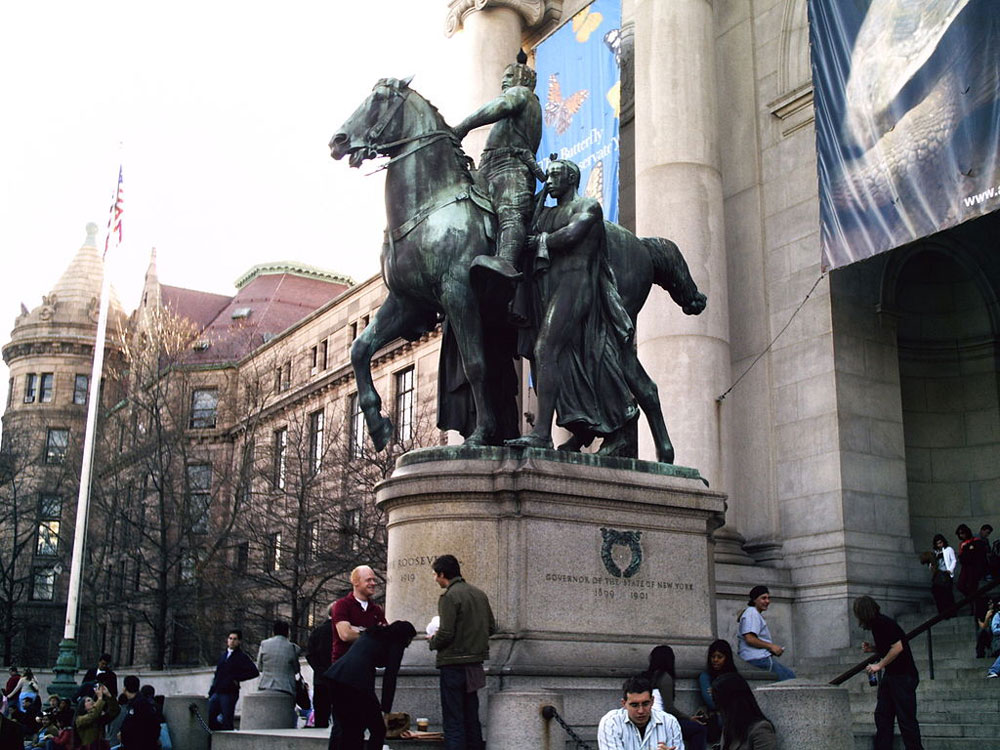
June 22, 2020; Hyperallergic and New York Times
For years, Indigenous groups and grassroots activists like Decolonize This Place have called on the American Museum of Natural History (AMNH) to remove a statue of Theodore Roosevelt on its steps, which shows Roosevelt astride a horse “towering over a Native American and an African,” as NPQ’s Martin Levine put it last fall. But it took the momentum of the historic Black Lives Matter protests and the toppling of racist monuments worldwide to finally persuade the museum to request that city remove the statue from its entrance.
Indeed, the museum’s leadership acknowledged the link between the national uprising and statue’s removal quite explicitly.
“Over the last few weeks, our museum community has been profoundly moved by the ever-widening movement for racial justice that has emerged after the killing of George Floyd,” the museum’s president, Ellen Futter, told Robin Pogrebin of the New York Times. “We have watched as the attention of the world and the country has increasingly turned to statues as powerful and hurtful symbols of systemic racism.”
The statue, made by James Earle Fraser, was constructed in 1940 and has greeted visitors at the museum’s entrance for 80 years.
As Pogrebin reports, the museum requested that the city, which owns the statue, remove it, which the city agreed to do on June 21st.
Sign up for our free newsletters
Subscribe to NPQ's newsletters to have our top stories delivered directly to your inbox.
By signing up, you agree to our privacy policy and terms of use, and to receive messages from NPQ and our partners.
In a statement, Mayor Bill de Blasio said, “The American Museum of Natural History has asked to remove the Theodore Roosevelt statue because it explicitly depicts Black and Indigenous people as subjugated and racially inferior. The City supports the Museum’s request. It is the right decision and the right time to remove this problematic statue.”
Pogrebin adds that, “When the monument will be taken down, where it will go and what, if anything, will replace it, remain undetermined.”
As Hakim Bishara for Hyperallergic explains, this decision by the museum comes after a nearly four-year-old public campaign. Bishara adds, “The recent protests against the monument go back to October of 2016 when the group Decolonize This Place organized the first Anti-Columbus Day tour inside the museum with the participation of other social justice movements.”
The city and the museum tried to initially split the difference, even offering an exhibit, called Addressing the Statue, in 2019, which included a new informational plaque added to the bronze that reads, “Some see the statue as a heroic group; others, as a symbol of racial hierarchy.” As Levine noted at the time, the half-measure was of dubious benefit: “For the American Museum of Natural History, does keeping Roosevelt standing tall, but surrounded by a fuller explanation, truly fulfill its mission and meet its values, or is it just a compromise to reduce the cost of change?” Levine asked.
As it happens, Theodore Roosevelt IV, the former president’s great-grandson, is a trustee at AMNH. In a statement, he offered his support for the removal of the statue. “The world does not need statues, relics of another age, that reflect neither the values of the person they intend to honor nor the values of equality and justice,” Roosevelt said. “The composition of the Equestrian Statue does not reflect Theodore Roosevelt’s legacy. It is time to move the statue and move forward,” he added.
In a statement released yesterday, Decolonize This Place said it welcomed the decision to remove the statue but noted that two of its demands to the city and the museum still remain unanswered: renaming Columbus Day to Indigenous Peoples’ Day and “transforming the museum’s racist exhibition spaces,” in addition to repatriating humans remains and sacred objects, and “taking on the work of reparations.”—Steve Dubb













